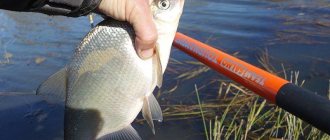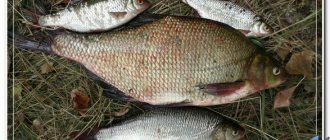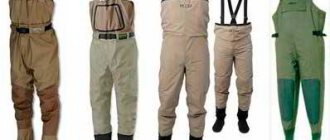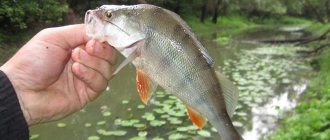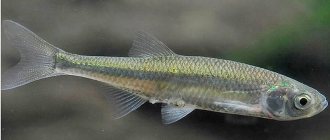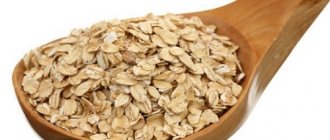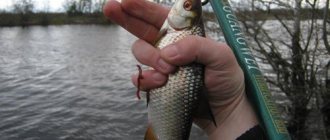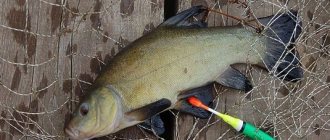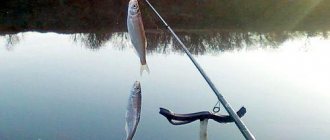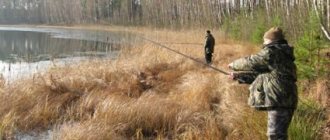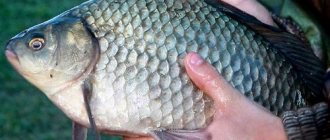October is the time for active perch fishing. Unlike pike and pike perch, this predator bites not only on various artificial baits and live bait, but also on traditional float tackle. The success of October perch fishing, as in the spring-summer period, depends on the correct choice of place, time and fishing tactics and bait.
Where and how to look for perch in October
Snag is the favorite habitat of perch.
In October, perch prefers to stay and hunt in such places as:
- Sun-warmed sandbanks bordering deep dumps;
- Snags and single flooded trees or bushes;
- Dumps of pits and pools;
- Exits from deep wintering pits;
- Islands of reeds surrounded on all sides by the depths;
- The channel part of a large reservoir or flowing lake.
In the coastal zone, among gradually dying aquatic vegetation, small “sailor” perches can feed for a long time.
Behavior of perch in autumn
With the onset of autumn, the behavior of the perch changes - the fish begins to actively feed, trying to accumulate the maximum amount of reserve nutrients necessary for further wintering. At the same time, the activity of the autumn perch is uneven throughout the entire autumn period:
- At the beginning of autumn, the activity of the predator is average, and in warm or even hot September it is quite low. At this time, medium and small perch continue to stay close to coastal thickets of aquatic vegetation and hunt mainly in the morning and evening hours. Large specimens live in pools and snags remote from the shore, going out to hunt in the shallows early in the morning and late in the evening.
- In mid-autumn, as the water temperature drops and aquatic vegetation dies off, perches of various sizes begin to flock into schools of large numbers and move away from the shore to deeper areas of clean water - dumps of deep holes and pools, snags. At this time, it bites throughout the day, provided the pressure is stable for several days and the wind is not strong.
- At the end of autumn, most of the schooling perch gradually moves after peaceful fish to deep wintering holes. At this time he feeds rather lightly - for 2-3 hours a day. But at the same time, if you get to the outlet of the perch, you can, along with medium and small fish, catch a fairly large and weighty humpback weighing more than 1 kg. Towards the end of November, as winter approaches and constant frost sets in, the perch bite subsides, only to resume on the first ice.
Thus, during the fall, perch gradually leaves summer camps near the coastline, moving to holes and pools for the winter. During such migration, schools of this fish actively feed on small fish.
Spawning in life and perch fishing

Spawning is a special period in the life of any type of fish, including perch. During spawning periods it is difficult to interest him with any bait. At the same time, perch has pre-spawning and post-spawning periods that deserve attention. Immediately after the ice melts, the perch leaves its winter mooring areas to head to shallow water. Such places are liked not only by perch, but also by other fish, especially small ones, which perch simply adores. The fact is that the water in the shallows warms up much faster than in the depths, therefore, most small fish accumulate in shallow areas.
Perch, gathered in schools, chases bleak, bream, roach, and also happily eats the eggs of spawned fish. Larger specimens of perch leave their hiding places only to “hunt” for white fish. At the same time, they do not mind swallowing their fellow creatures. This period is called pre-spawning zhor. It is characterized by the fact that perch can be caught using any tackle and any bait of animal origin, such as bloodworms, worms, pieces of fish or live bait.
Spinning fishermen use completely different artificial baits, such as spinners or jigs. This period can last about a week, and will end literally before spawning.
After spawning, the perch begins to eat again, and it can again peck at any animal bait. This is the most interesting and productive period of perch fishing.
Catching perch with float tackle
Successful perch fishing with a float rod in October requires not only knowledge of the habits and food preferences of this fish at this time, but also the choice of the most suitable and correctly assembled gear, bait and fishing technique, taking into account the weather, for certain conditions.
What should the tackle be like?
In order for fishing to be catchy and comfortable, all its components - rod, reel, fishing line, float, hooks and weight must be selected correctly.
Let's analyze the choice of each of the above components of gear separately.
Rod
When float fishing for October perch, the choice of rod type and length depends on the conditions in which you plan to catch this fish:
- For small flowing lakes and ponds, when fishing from the shore, light fly rods 4-5 m long are used.
- When fishing in large and medium-sized bodies of water, fly and Bolognese rods 7-8 m long are used.
- Short 4-5 meter fly rods and Bolognese rods are more suitable for boat fishing.
At the same time, experienced fishermen give preference to models made of carbon fiber or high-quality composite. Compared to cheap fiberglass rods, such rods are lightweight, highly flexible and sensitive.
Coil
When fishing with Bolognese rods, the float rod is equipped with the following types of reels:
- Spinning reel size 500-1000 with front clutch and 2-3 bearings in the handle and drive mechanism;
- A simple bobbin (inertial) reel with a spool with a diameter of 40-50 mm;
Daiwa Crest 3500. Spinning reel. 400g, 4.9:1. Maximum load 6 kg. Vietnam. Average price from 4560 rub.
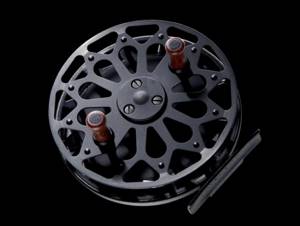
Nelma. A simple inertial coil, the price starts from 550 rubles.
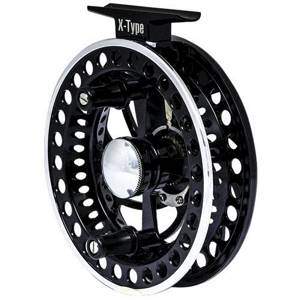
Reliable and trouble-free reel. Price from 11 thousand rubles (for 2018) Inertia-free models are more convenient and reliable - they allow, if necessary, to quickly and effortlessly reel in the fishing line, have a more capacious spool, and can be used to make fairly long casts of heavy equipment. Their only drawback is their higher price than budget reel models.
Main line
Float tackle for catching perch is equipped with a strong and thin monofilament fishing line with a cross-section of 0.16-0.18 mm . Colorless monofilaments are more preferable when fishing in clear water.
Float
Floats with a spindle-shaped or teardrop-shaped body, a long, brightly colored antenna and a load of 3.5-6.0 g are used as bite alarms. An article on making floats with your own hands at home.
Loading
Options for lead sinkers
To load the float, pellet sinkers are used that are fixed on the fishing line. In this case, 20-25% of the load (0.7-1.5 g) is attached to the place where the leash and the main line are attached, and the rest (3-4.5 g) is 25-30 cm higher. This division of the load allows you to increase the sensitivity of the float and increase the percentage of realized bites.
Leash with hook
The float tackle used for catching October perch uses a leash made of monofilament fishing line with a cross-section 0.02 mm thinner than the main fishing line. The length of the leash should be no more than 15-20 cm.
When catching perch with a large worm and leech, hooks Nos. 8-10 are used. For smaller baits - bloodworms, maggots - use hooks with a long shank No. 12-14.
How to catch perch in October using a float
Catching perch with float tackle in October consists of fairly simple steps:
- Search for a place - a section of a reservoir with differences in depth, flooded snags, a sandy beach bordering a hole or a pool;
- Determining the depth at the fishing site using control measurements with a float or wireless echo sounder. When using the latter, along with depth, the presence of fish and its location in the water column are also determined.
- Baiting and throwing the rig to the fishing point - despite the fact that the perch is not shy, you should carefully throw the rig to the intended place, trying not to make it slap or hit the water. After casting, it is advisable to sit down on a stool, chair or just a stump so that the fish, due to the refraction of light in the water, cannot notice the fisherman standing at full height on the shore.
- Hooking and landing fish - when the float moves sharply downwards, you should make a short and sharp hook. You can catch hooked small and medium-sized perch quickly and safely. Large specimens that offer more fierce resistance are fished out carefully, with strong jerks releasing a small amount of fishing line from the reel, while keeping it in a constantly taut state.
Tackle for fishing
In the autumn, representatives of the perch community are caught with the same gear that is used by fishermen in the summer. Depending on the preferences of the fisherman himself, he can use mainly one piece of equipment, or use several pieces of equipment at the same time.
The most common way to catch perch is, of course, with a spinning rod. This equipment is customized by each fisherman individually and in this case any advice is simply useless. Everyone uses the spinning rod and spinning equipment that they like best, and are most suitable for their convenience and fishing conditions.
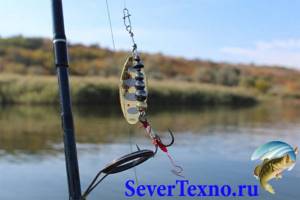
In addition, many anglers still prefer to conduct perch hunting using conventional float-type fishing rods, using a wide variety of types of live bait or other natural baits of animal origin for bait.
When catching perch in October with the help of circles, live bait is also used, which is caught in the same reservoir, or purchased in advance in fishing stores. But fishing with circles will require the angler to have a boat.
For spinning
When catching perch with spinning gear, the first step to successful fishing is the correct configuration of this gear - choosing the most suitable rod, reel, and cord for the fishing conditions.
Choosing a spinning rod and reel
The choice of a spinning rod depends on the fishing conditions:
- When fishing from a boat , as well as in small reservoirs, rods with a length of 180-220 cm will be most suitable.
- For medium- sized rivers and lakes, spinning rods 240 cm long are used
- For large reservoirs and large rivers, river backwaters, spinning rods with a length of 270-300 cm are most suitable.
Since small-sized baits are used for catching perch, the test of the selected form should be no more than 15-20 g. When fishing with microjig baits, the most delicate and sensitive forms with a casting of 1-7 g are used.
Also, the choice of a rod for catching perch is influenced by what kind of bait you plan to use - for example, for fishing with silicone baits, special jig rods with a thin tip are used; for fishing with a wobbler and spinner that creates significant resistance when pulling, they use stiffer and shorter twitching rods.
Coil
For spinning tackle used in perch fishing, a spinning reel with the following characteristics is used:
- Size according to Shimano classification – 1500-2000;
- Body material – carbon or aluminum;
- Number of bearings – at least 3;
- The location of the friction brake is front;
- Gear ratio 4.7-5.1:1.
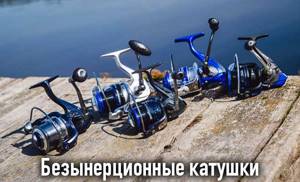
Such a reel should have two spools included - graphite (for monofilament) and aluminum (for braided cord).
Line or cord
When catching perch with spinning tackle, both ultra-thin braided cords with a cross-section of 0.06-0.1 mm and monofilament fishing line with a thickness of 0.18-0.25 mm are used.
Choosing bait
In spinning fishing for autumn perch, baits such as wobblers, spoons, twisters, vibrotails, crustaceans, and slugs are used.
Wobblers
For perch, wobblers of the shad, crank and minnow classes with varying degrees of buoyancy are used - suspenders, sinking and floating. The length of such baits should be no more than 5-6 cm, and weight up to 15 g.
In October, the most attractive to the striped predator are wobblers of silver, golden, yellow and bright red color.
Among lures of this type, the most popular among perch fishermen are models from such brands as:
- Jackall;
- Jackson;
- YO-ZURI;
- Salmo;
- Strike Pro.
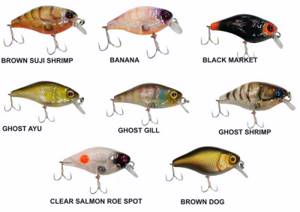
Jackall. Chubby line (plump)

Jackson (Jaxon)

Salmo
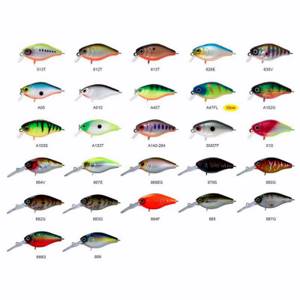
Strike Pro

Spoons
In the fall, perch is caught mainly with small rotating and narrow oscillating spoons weighing up to 10-15 g, silver or golden in color. Among the variety of these lures for catching perch at this time of year, such models as Mepps Aglia, Mepps Aglia Long, Blue Fox Super Vibrax, Pontoon21 Ball Concept No1.5, ACME Kastmaster SW-138 have proven themselves well.
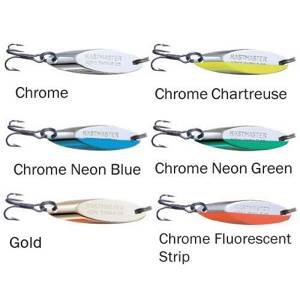
Acme series Kastmaster
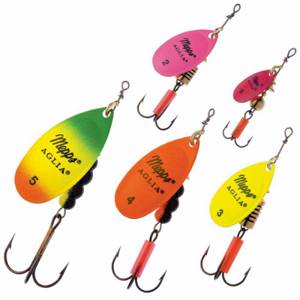
Mepps
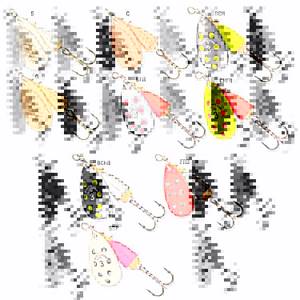
Blue Fox Super Vibrax
Silicone baits
Among the variety of silicone baits in mid-autumn for catching perch, the most catchy ones are:
- Twisters are silicone baits with a spindle-shaped smooth or corrugated body at the end of which there is a movable spiral tail;
- Vibrating tails are silicone fish with a movable “heel” tail;
- Crustaceans are baits that very realistically imitate various small crustaceans;
- Slugs are worm-shaped baits with a thin and motionless tail.
The length of such baits should be no more than 5 cm. Our rating of edible rubber for perch.
Equipment options
Most often, perch is caught on a spinning rod, using various lead rigs, in which the bait and the sinker holding it at a certain depth are not combined in a traditional jig head, but are located separately. Thanks to this, the angler can cast even the lightest bait over a long distance, guide it through snags, flooded bushes and other places that are dangerous for snagging.
Among such equipment, the most widely used are the following:
- Caroline - consists of a fluorocarbon leash 40-70 cm long with an offset hook and a twister or vibrotail attached to its end. The other end of the leash is tied to a simple swivel at the end of the main line or cord, behind which on the line there is a large stop bead and a conical sliding weight (“bullet”) weighing 10-12 g.
- A drop shot is a meter-long piece of fishing line with a pear-shaped or stick-shaped weight weighing 10-12 g at the end and a silicone bait (twister or vibrotail) attached to an offset hook, tied to the fishing line using special “Palomar” knots 40-50 cm above the sinker.
- Branch leash - a leash with a sinker weighing 10-15 g is attached to the lower branch of the triple swivel, a long piece of fluorocarbon or monofilament fishing line 70-150 cm long is attached to one of the remaining two branches, at the end of which a twister with an offset hook is tied. The main fishing line or braided cord is tied to the remaining third branch of the swivel.
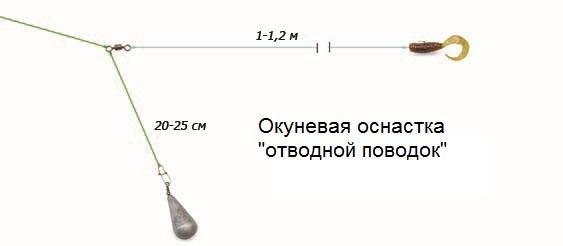
Diversion leash diagram
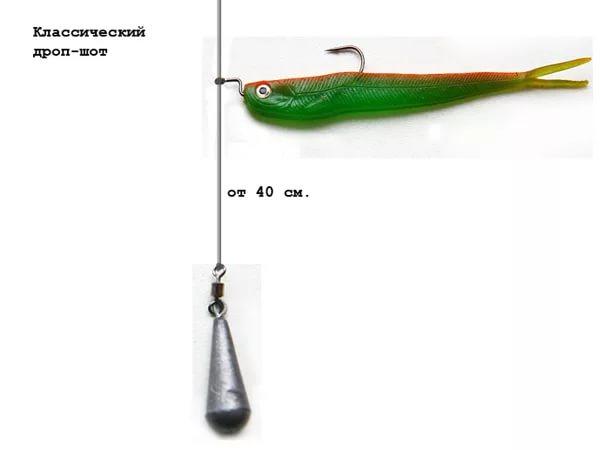
Drop shot (click to enlarge)
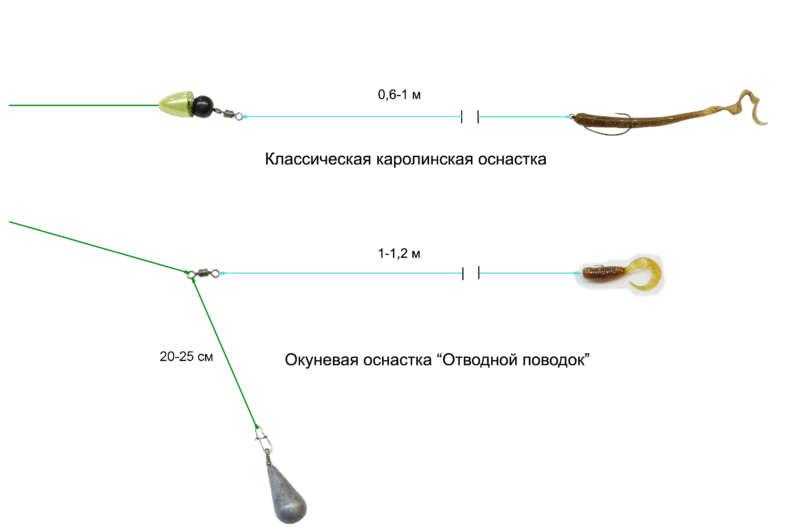
Carolina rig
Tackle and bait
A big piece makes your mouth happy. In specific autumn conditions, it cannot be said that this expression works. A passive fish will not waste its efforts on elusive large prey. Therefore, the tackle should be thinner and more delicate than in summer (read more about catching perch in summer).
The choice of spinning rod depends on several parameters. First of all, this is a test. The upper and lower limits of the working scales should be selected for specific fishing conditions. It is worth noting that microjig is the highest priority fishing method (we wrote about catching perch with microjig here). The optimal autumn weight, for depths up to 2 meters, without a current, is 1.5-2 grams with a cord thickness of up to 0.8 mm. Light blasts with a rod with long pauses are the ideal animation of a silicone bait.
However, there are other variations of the game. The so-called “drawing” involves pulling crustacean or worm-like silicone from a shallow to a deeper area. It is worth noting that the most effective baits are passive species. All kinds of worms and their variations perfectly attract predators. The color scheme depends on the transparency of the water.
Techniques for catching perch using a spinning rod
When catching perch with spinning tackle, it is important to correctly perform such basic elements of fishing techniques as casting, retrieving, hooking and retrieving.
Casting
When catching perch, use light-weight lures, cast at short and medium distances using vertical or lateral casting methods. The latter is relevant in a limited space of banks overgrown with bushes and trees.
Wiring
When fishing for October perch, depending on the activity of the predator, the following fishing techniques are used:
- Uniform - winding a cord or fishing line with a bait thrown into the water by uniformly rotating the reel handle
- Stepped - after casting, the bait is allowed to sink to the bottom, then it is raised by winding the line with a reel, performing 3-4 turns of the handle, making a pause, during which the bait smoothly sinks to the bottom, and rewinding again. With this type of wiring, the bait moves in steps, either rising from the bottom into the water column, then falling or gliding back to the bottom soil.
- Jerk - used when fishing with floating and sinking wobblers. Its essence is to perform sharp and short jerks with the tip of the blank while guiding the bait through the water column.
- “Stop and go” - used when fishing with wobblers with neutral buoyancy “hovering” in the water column and consists of reelings (3-4 turns of the reel handle) and short pauses lasting 1-3 seconds, during which the bait freezes in a certain layer of water and is usually attacked by perch.
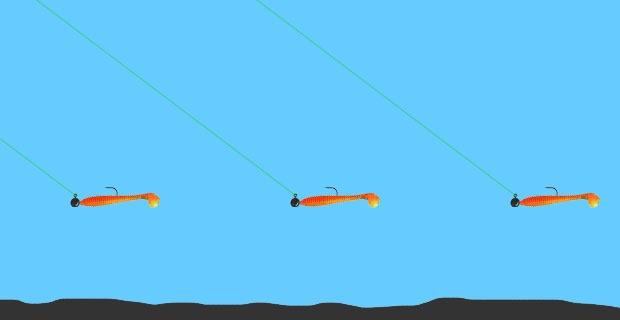
Uniform wiring

Hooking and landing
The bite of a perch on a spinning tackle - a short single or several strong frequent strikes on the bait - is quite sensitive and, most often, is not only clearly visible only at the tip of the rod blank, but is also felt by the hand holding the spinning rod (“gives it to the hand”). Hooking should be done with a sharp wrist movement of the hand.
When fishing for especially large specimens, the rod should be held at an angle of no more than 450, alternating winding the line with a reel and pulling the hooked fish to the shore with a blank. This fishing strategy will allow you to evenly “load” both the reel and the form itself, avoiding their breakage and the removal of hooked fish.
Video on catching large perch using a spinning rod in October and November
What to fish for and which method to choose
Perch, depending on the weather, can be in any layer of water. To catch him, use all available methods:
- spinning (classic, microjig, ultralight)
- float rod
Each method is catchy and no worse than the other. Depending on the conditions or personal preferences, a choice is made in favor of one of them. In turn, each has its own list of baits used.
Spinning:
- spinner
- oscillating spoon
- silicone baits
- wobblers
Float rod:
- worm
- whitebait
- jig
Let's take a closer look at each of these bait methods. Beginners may be wondering which is the best. In this case, everyone decides for themselves, choosing the best option based on the information below.
Classic spinning
The most versatile option, the undoubted leader. Allows you to fish large areas and all layers of water. In the case of using a boat with no competitors at all. Spinner spinners are used, with petals from 3 sizes, silver and copper colors.
Wobblers no more than 7 cm, as large models are more likely to attract pike. When using silicone baits, you can enlarge and use from 2.5 to 3.5 inches (5-8 cm) in natural colors: blue, transparent, white. The emphasis is on making the bait as suitable as possible for a real fry or insect.
Microjig
Microjig is a subtype of spinning fishing. Recently it has been actively gaining momentum. To get maximum pleasure, you need to be picky about your rod. A thin, sensitive blank with a light spool and thin cord is required.
According to the principles of fishing, it is no different from the classic jig, except for micro baits and sinkers. Not a very good choice for October; in windy weather it is difficult to cast light tackle. But with a perch bite you will get a lot of pleasure, the sensations will be like from a serious pike.
Ultralight
Similar to the previous method, the difference is in the baits used:
- microoscillators
- micro turntables
- small wobblers
The idea is simple: use an Ultra Light rod with a weight of up to 5-7 grams. It will be comfortable in sunny and windless weather. Once the October wind picks up, it will be very difficult to make an accurate and long cast. The conclusion is that it is extremely dependent on conditions.
Fishing with a float rod
Significantly inferior to spinning. Firstly, if a school of perch is located far from the shore, then it will be impossible to cast to them. Secondly, in search of a fish site, you will have to go through more of the coastal zone; due to restrictions on the casting range, a smaller water area is fished.
Float fishing is a fundamentally different fishing method. There are a lot of his connoisseurs and admirers, and this is not surprising. Sometimes you want to sit quietly in one place (having found a cool place), observing the behavior of the float or the tip of the rod.
On the worm
An accessible and catchy method. Perch is not averse to eating animal food. The hardest part is finding a parking spot. To attract attention to the fishing point, use bait with the addition of a worm, maggot or bloodworm.
Make casts:
- to the grass
- driftwood
- fallen trees
- bridge supports
- into the pits
For fry
You need a small fish (screen) - a square net for catching live bait. Having tied it to a fishing rod or stick, you throw it into the water. Crumble bread or bread crumbs on top. Small things float onto the dregs and when you lift the screen out, they all remain in the mesh.
Place the bait under the top fin and throw it into the water. Be sure to use a float to adjust the fishing depth. Live fry are active, excellent at attracting minke whales. Occasionally twitch the rod to move the bait. Read more about catching perch with fry.
On the jig
A special side nod is mounted on the last knee of the rod. A fishing line is passed through it and a jig is tied. In this method, the length of the fishing rod is important, allowing you to deliver the bait as far as possible from the shore.
After throwing, start playing with the blank a little, creating small vibrations. At the same time, lift the rod, passing through all water layers: from the bottom to the surface. The next time you cast, try casting in the reverse order: from the surface to the bottom.
Blitz tips
- “Perch boilers” are a large concentration of perch surrounding a school of fry and actively devouring them. You can notice this phenomenon even from afar by the seething water in it and the splashes of a feasting predator. Passing almost any artificial bait through the “cauldron” is a 100% guarantee of catching a medium or even large perch.
- When fishing with float tackle and spinning rods, you can use live bait as bait - crucian carp, roach, perch.
- An extractor and a yoke are the necessary tools for removing a hook that is deeply embedded in the mouth of a perch during self-hooking.
- A metal leash for spinning fishing is necessary in places where, along with a striped predator, the bait can be attacked by pike or pike perch
- It is better to release the caught sailor perch in reservoirs with a small number of this fish, thereby not depriving yourself of the chance to catch in the future a respectable humpback salmon that has grown from a small fish.
